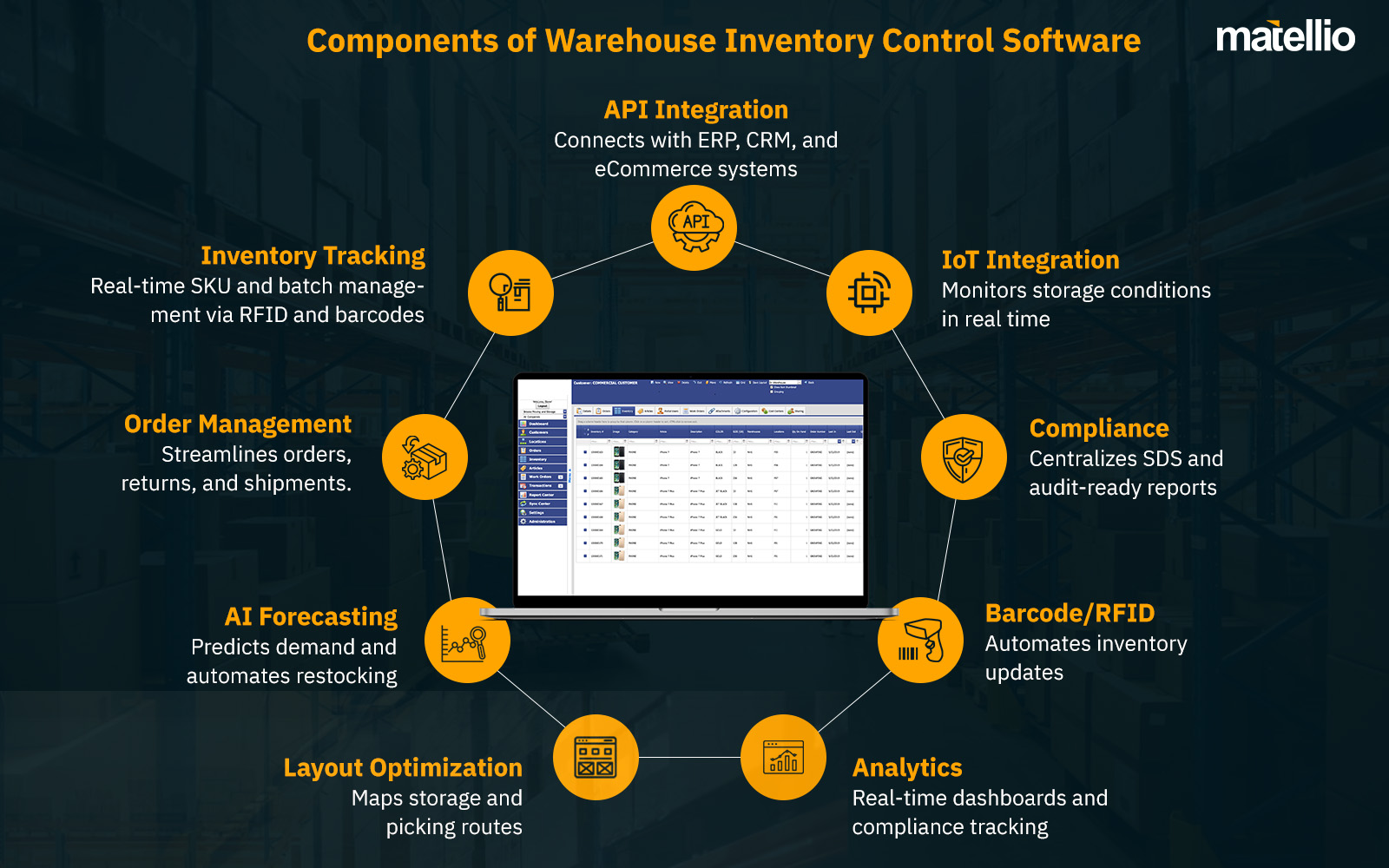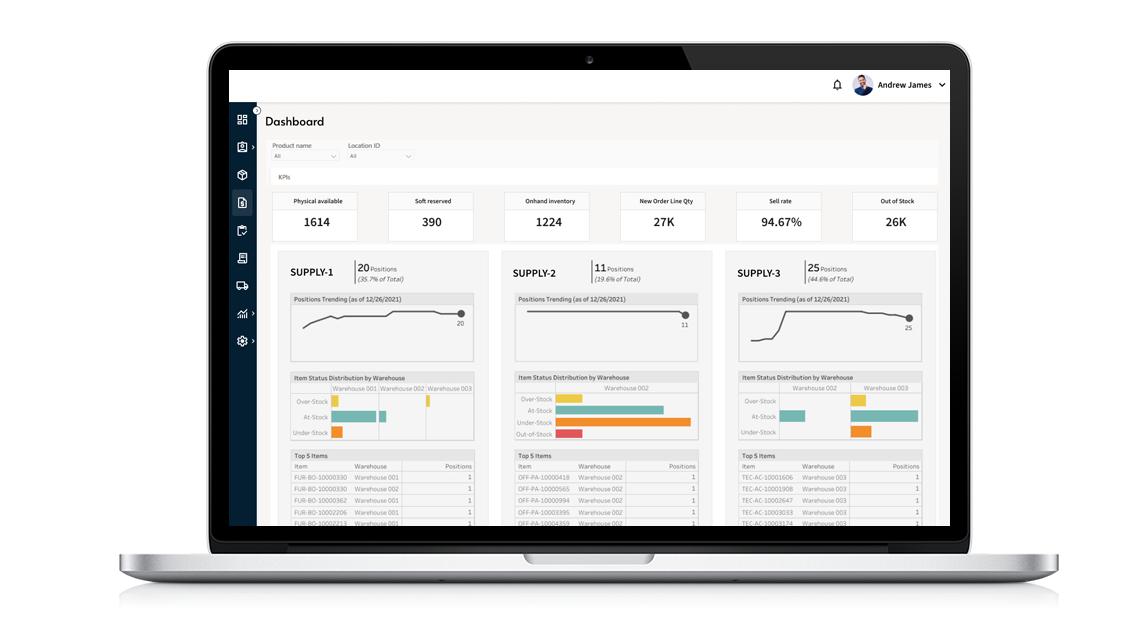
You’re probably thinking, ‘Another software pitch? Great.’ But hear us out. This isn’t just about some fancy new tool. This is about survival. In today’s hyper-competitive market, inventory is king. Mismanage it, and you’re playing with fire. Out-of-stocks mean lost sales. Overstocking means wasted capital. And let’s not even talk about the nightmare of manual entry and reconciliation. That’s exactly where warehouse inventory control software comes into play!
Imagine a custom inventory control software for warehouse that thinks like your business, anticipates your needs, and eliminates the guesswork. Warehouse inventory control software offers you:
- Real-time visibility into every single item in your warehouse.
- Automated alerts that warn you of potential stockouts or surpluses.
- Effortless order fulfillment that gets products to your customers faster than ever before.
- Data-driven insights that reveal hidden opportunities and empower you to make smarter, more profitable decisions.
Intrigued? So, why not develop an inventory solution like this for your company? Don’t worry; we have got you covered! In this blog, we will not only explore the benefits and use cases of warehouse inventory control software but also discuss its features, tech stack, and the development process.
What is Warehouse Inventory Control Software
If you’re wondering, warehouse inventory control software isn’t just another tool—it’s the solution to your everyday warehousing challenges. It’s a software system designed to bring order to the chaos of inventory management, whether you’re dealing with misplaced stock, inaccurate data, or operational bottlenecks.
At its core, warehouse inventory management software helps you track, manage, and optimize your inventory from the moment it enters your warehouse to when it’s shipped out. But it’s more than just tracking; it’s a complete upgrade to how your warehouse operates.

In short, warehouse inventory control software is the foundation for a smarter, more efficient warehouse. It’s not just about tracking inventory—it’s about optimizing your entire operation to:
- Save Time: Automate manual tasks and reduce delays.
- Cut Costs: Eliminate overstocking, stockouts, and errors.
- Boost Accuracy: Ensure every item is accounted for, from receiving to shipping.
- Improve ROI: Faster processes, better data, and lower costs translate directly to higher profits.
For warehouses of any size, warehouse inventory control software development isn’t just a smart investment—it’s the key to staying competitive in today’s fast-paced logistics landscape. Whether you’re managing a small warehouse or a multi-location operation, this software will revolutionize the way you work. Submit RFP to get started today!
Read More: Unlock the power of multi-warehouse inventory management software to streamline operations, optimize stock levels, and enhance supply chain efficiency.
Why Invest in Warehouse Inventory Control Software Development
As a business owner, if you’re constantly searching for ways to improve efficiency, reduce costs, and gain a competitive edge then developing warehouse inventory management software is the only option. Investing in the development of custom warehouse inventory control software is not an expense; it’s an investment in your future success. Well, that’s what the market scenario reveals!
According to Grand View Research, the global warehousing system market is projected to grow at a CAGR of 19.5% from 2024 to 2030. And that’s not all!

But these are not the only reasons. Here’s why investing in inventory software for warehouse can be beneficial:
 Real-Time Stock Visibility for Faster Operations
Real-Time Stock Visibility for Faster Operations
Tired of wasting time searching for products that aren’t where they’re supposed to be? Warehouse inventory monitoring systems give you real-time updates on stock locations. You can instantly see what’s available, where it’s stored, and how much you have—all through a handheld device or dashboard. Plus, with RPA services, all these tasks would not even require any human assistance!
Real-time stock visibility prevents delays, eliminates stock discrepancies, and ensures smooth order fulfillment, saving time and avoiding unnecessary labor costs.
 Automate Tedious Tasks and Eliminate Errors
Automate Tedious Tasks and Eliminate Errors
Imagine no longer manually entering stock data, counting products shelf by shelf, or double-checking entries. With distribution inventory management software for the warehouse, these tasks are automated. Barcode scanning and real-time tracking mean fewer headaches and faster workflows.
Automation reduces costly mistakes caused by human error, like stockouts or overstocking, and ensures your data is always accurate. That means less waste, better decisions, and a more efficient warehouse.
 Make Picking, Packing, and Reordering Easier
Make Picking, Packing, and Reordering Easier
Ever had to pick orders in a warehouse only to find out the product isn’t where it should be? Warehouse stock management software, when paired with AI integration services, creates smarter picking routes, ensures stock is always in the right location, and alerts you when items need replenishment. Your work gets faster, smoother, and more accurate.
Optimized picking and packing directly improve delivery times, reduce labor hours, and increase customer satisfaction. Faster reordering means you’re always prepared, avoiding stockouts and missed opportunities.
 Cut Costs and Boost Efficiency
Cut Costs and Boost Efficiency
Less time spent on repetitive manual tasks means more time to focus on meaningful work that improves the warehouse overall. Warehouse inventory management software ensures stock levels are optimized. No more overstock sitting idle or excess storage costs.
By reducing waste and improving inventory turnover, you’ll see an immediate improvement in cash flow.
 Improve Safety and Reduce Workload
Improve Safety and Reduce Workload
Manually handling hazardous or bulky items is risky and tiring. Warehouse inventory monitoring systems track these items, ensuring proper storage and handling while minimizing the need for manual checks.
Safer working conditions mean fewer injuries, lower insurance costs, and higher employee satisfaction—creating a positive work environment while protecting your bottom line.
 Provide Better Customer Experiences
Provide Better Customer Experiences
You’ll feel proud knowing the orders you handle are processed quickly and accurately, thanks to automated systems that ensure the right products are delivered on time. Happy customers mean repeat business.
Software for warehouse inventory management ensures faster deliveries, error-free orders, and better reviews, all of which contribute to higher sales and better ROI.
 Effortless Compliance and Reporting
Effortless Compliance and Reporting
No more scrambling to find paperwork or worrying about audits. Automated reporting and SDS tracking, offered by report automation software, make compliance easy and hassle-free. With accurate data and instant reports, you’ll meet regulatory standards without stress, protecting your business from fines or legal issues.
The Bottom Line: ROI You Can See and Feel
Investing in warehouse inventory control software development means no more inefficiencies, wasted money, or frustrated teams. Instead, you’ll get a streamlined, profitable warehouse where everything works exactly as it should. So, why wait to transform when you can begin today?
Also Read: Learn how building an inventory app like Sortly can streamline business operations, enhance inventory management, and improve overall efficiency with a step-by-step development guide.
Ready to Transform Your Warehouse with a Custom Solution? Get Started with a Free 30-minute Consultation!
Key Features of Warehouse Inventory Control Software That Drive ROI
Congratulations on finally starting the project. So, you have felt the need for warehousing software solutions. But did you know that the right mix of features for your warehouse inventory control software is critical as it lays the foundation for long-term success and ensures your operations are optimized to deliver maximum ROI?
The right features will not only address your current challenges but also future-proof your warehouse for scalability and innovation. But you don’t have to worry about picking the right features!
As a trusted provider of digital transformation services, we’ve hand-picked 12 must-have features for your inventory software for warehouse operations.
 Real-Time Inventory Tracking
Real-Time Inventory Tracking
This feature ensures you know exactly what’s in your warehouse, where it’s stored, and how much is available. With warehouse inventory tracking software, real-time updates prevent stockouts, overstocking, and wasted time spent searching for misplaced items. Your software should give workers instant access to inventory levels, empowering faster and more accurate decision-making.
 Barcode and RFID Integration
Barcode and RFID Integration
Barcode and RFID technology automates stock updates as items move in and out of your warehouse. This eliminates manual errors and ensures accurate data across all SKUs. Incorporating this into your inventory control software for warehouse not only saves time but also streamlines processes like picking, packing, and cycle counts.
 Order Management and Fulfillment
Order Management and Fulfillment
Your warehouse inventory software should integrate order processing with inventory tracking, ensuring that every order is fulfilled accurately and on time. This feature, powered by system integration services, helps eliminate delays, improve order accuracy, and boost customer satisfaction, directly impacting your bottom line.
 Stock Replenishment Automation
Stock Replenishment Automation
This feature automatically triggers reorders when inventory drops below a predefined level. By integrating demand forecasting, your warehouse inventory management software ensures that critical products are always in stock, avoiding downtime and lost sales.
 Compliance Management and Reporting
Compliance Management and Reporting
Staying compliant with regulatory requirements like OSHA or GHS is non-negotiable. Your software should automate the tracking of Safety Data Sheets (SDS) and generate audit-ready reports. This not only saves time but also shields your business from costly fines or shutdowns. You can further enhance this feature by leveraging AI development services.
 Workflow Automation
Workflow Automation
Repetitive processes like inventory reconciliation, invoice generation, and shipment scheduling can consume valuable hours. By integrating warehouse inventory control software with automation tools, you can simplify workflows, reduce manual effort, and free up staff for higher-value tasks.
 AI-Powered Demand Forecasting
AI-Powered Demand Forecasting
Unlike standard solutions, advanced warehouse inventory software incorporates AI to analyze historical trends, seasonality, and external factors like market demand. This feature helps predict future inventory needs with unmatched accuracy, ensuring optimal stock levels and improved cash flow.
 IoT-Enabled Environmental Monitoring
IoT-Enabled Environmental Monitoring
For industries dealing with perishable or hazardous goods, IoT integration services are invaluable. Your inventory software for warehouse can monitor environmental factors like temperature and humidity in real time, ensuring sensitive products are stored safely. Alerts are triggered for anomalies, reducing waste and risks.
 Warehouse Layout Optimization
Warehouse Layout Optimization
Using advanced algorithms, this feature maps out the most efficient storage and picking routes. Your warehouse inventory management software should optimize bin placement to reduce travel time and labor costs, improving overall efficiency.
 Advanced Cycle Counting and Slotting Optimization
Advanced Cycle Counting and Slotting Optimization
Cycle counting is critical to inventory accuracy, but manual processes are time-consuming. Advanced warehouse inventory tracking software automates cycle counts and uses slotting optimization to assign the best storage location for every SKU based on turnover rates and space utilization, maximizing efficiency.
 Advanced Analytics and Custom Dashboards
Advanced Analytics and Custom Dashboards
Standard software provides basic reports, but advanced warehouse inventory software offers detailed, customizable dashboards. From inventory turnover to worker productivity, this feature helps managers and owners make data-driven decisions that directly impact ROI. Pairing your custom solution with predictive analytics software development helps you with predictive analytics and reporting part.
 Robotic Process Automation (RPA)
Robotic Process Automation (RPA)
RPA automates repetitive tasks like data entry, invoice generation, and inventory reconciliation. Incorporating RPA into your inventory control software for warehouse not only saves time but also ensures higher accuracy and efficiency. This is a game-changer for high-volume operations.
Well, the list doesn’t end here! You can schedule a free 30-minute consultation with our experts to get more exclusive features for your project.
Also Read: Explore how Custom Retail Operations Software can streamline your business by unifying processes with AI-driven decision-making and advanced analytics for smarter operations and enhanced efficiency.
Tech Trends that Can Further Add Value to Your Investment
As a trusted digital transformation consultancy, we understand that developing warehouse inventory control software is just the beginning. True transformation lies in continually enhancing its capabilities to keep up with market demands and operational complexities.
That’s why we offer technology consulting services, helping you integrate next-gen technologies into your existing solution. These cutting-edge tech trends don’t just make your warehouse inventory management software smarter—they bring real value by optimizing efficiency, improving decision-making, and driving ROI.
Here are seven game-changing trends you can integrate into your inventory control software for warehouse operations:
AI-Powered Predictive Analytics
AI takes your warehouse inventory tracking software to the next level by analyzing historical and real-time data to predict future trends. With predictive analytics and ML model development services, you can forecast demand, optimize stock levels, and even predict potential supply chain disruptions. This means no more stockouts, overstocking, or wasted storage space—just perfectly optimized inventory.
- Reduces inventory carrying costs.
- Optimizes demand forecasting.
- Identifies inefficiencies in stock movement.
- Improves cash flow and resource allocation.
Robotic Process Automation (RPA)
RPA enhances software for warehouse inventory management by automating repetitive tasks such as data entry, order processing, and compliance reporting. With RPA, your team can focus on more strategic tasks while maintaining high operational accuracy and efficiency.
- Streamlines order and data processing.
- Reduces manual errors.
- Speeds up compliance reporting.
- Improves staff productivity.
IoT for Real-Time Monitoring
Integrating IoT sensors into your warehouse inventory control software enables real-time monitoring of stock conditions, such as temperature, humidity, and location. This is especially beneficial for industries handling perishable or hazardous goods. Alerts for anomalies ensure immediate action, preventing spoilage, accidents, or regulatory issues.
- Ensures proper storage conditions.
- Tracks stock movement in real time.
- Prevents spoilage and loss of goods.
- Reduces risk with automated alerts.
Computer Vision for Inventory Tracking
Computer vision services enhance the accuracy of warehouse stock management software by automating inventory tracking and stock counting. Cameras powered by AI can visually scan inventory shelves, identify misplaced items, and update stock data in real time. This not only improves inventory accuracy but also reduces the time spent on manual stock counts.
- Automates inventory audits and updates.
- Identifies discrepancies instantly.
- Reduces dependency on manual labor.
- Speeds up stock verification processes.
Advanced Warehouse Navigation with AI
AI-powered navigation tools can guide workers through the most efficient picking and packing routes. By analyzing the warehouse layout and real-time stock data, this technology ensures that workers spend less time traveling between aisles and more time fulfilling orders.
- Reduces time spent on picking routes.
- Increases order fulfillment speed.
- Lowers labor costs.
- Improves operational efficiency.
Advanced Analytics and Dashboards
Most warehouse inventory software includes basic reporting, but advanced analytics takes it further by delivering actionable insights in real time. From identifying slow-moving inventory to analyzing worker productivity, these dashboards help managers make data-driven decisions to improve operational performance.
- Provides actionable insights.
- Tracks productivity and bottlenecks.
- Optimizes storage space utilization.
- Improves decision-making with real-time data.
Voice-Activated Operations
Voice technology can transform your warehouse inventory management software by allowing workers to perform tasks hands-free. Workers can receive picking instructions, update stock levels, or check inventory through simple voice commands, improving productivity and reducing errors.
- Enables hands-free operations.
- Reduces human errors in stock updates.
- Speeds up task completion.
- Improves worker productivity.
To summarize, we have:
| Technology | What It Adds |
| AI Predictive Analytics | Optimizes inventory, reduces costs, forecasts demand. |
| Computer Vision | Automates stock counting, reduces manual errors, identifies misplaced inventory. |
| IoT | Monitors stock conditions, tracks movement in real time, prevents spoilage. |
| RPA | Automates tasks, improves compliance reporting, reduces data entry errors. |
| AI Navigation | Optimizes picking routes, reduces labor time, improves order accuracy. |
| Advanced Analytics | Provides actionable insights, tracks bottlenecks, and improves operational decisions. |
| Voice-Activated Operations | Enables hands-free task execution, reduces errors, and improves worker productivity. |
By integrating these technologies into your warehouse inventory control software development, you don’t just modernize your system—you redefine your warehouse’s operational capabilities.
Also Read: Discover how AI-powered inventory planning software can minimize project delays and cost overruns with smart forecasting and real-time optimization.
Want to Implement the Latest Tech Trends in Your Software? Contact Our Experts Over a Free 30-minute Call!
How to Develop Warehouse Inventory Control Software in 6 Easy Steps
Developing warehouse inventory control software can revolutionize your business operations, but to unlock its true potential, you need expert guidance and a well-thought-out plan. Building a software solution tailored to your warehouse’s needs isn’t just about coding—it’s about creating a foundation for efficiency, accuracy, and long-term ROI. As a business owner, you’re ready to embark on this journey, and we’re here to guide you every step of the way.
Below are six essential steps to developing your own warehouse inventory management software, ensuring your investment yields maximum value.
 Define Your Goals and Assess Your Needs
Define Your Goals and Assess Your Needs
Before you start, take a deep dive into your business requirements. Ask yourself and your team:
- What problems are you trying to solve? (e.g., stock discrepancies, operational inefficiencies, compliance challenges).
- Which features are essential for your warehouse? (e.g., warehouse inventory tracking software, demand forecasting, barcode integration).
- How scalable should the software be to handle future growth?
This phase is critical because it shapes your entire warehouse inventory control software development process. Leverage data consulting services to analyze your existing data and identify pain points, trends, and operational gaps that need to be addressed.
 Partner with a Trusted Warehouse Management Software Development Company
Partner with a Trusted Warehouse Management Software Development Company
Creating software for warehouse inventory management is a complex process that requires expertise in software engineering, logistics, and compliance. A professional warehouse management software development company will:
- Help you select the right tech stack and architecture for your software.
- Design a solution tailored to your business needs, ensuring it scales with your operations.
- Provide advanced features, such as AI-based forecasting, IoT integration, and automation tools.
- Offer long-term support for updates, maintenance, and new feature integration.
Partnering with experts ensures that your software is robust, scalable, and equipped with all the essential tools to meet your business goals.
 Develop an MVP First
Develop an MVP First
Rather than building the entire system at once, start with a Minimum Viable Product (MVP). This approach focuses on delivering core features first, allowing you to test the solution in a live environment.
Why MVP Development Services Matter:
- Test key features like inventory control software for warehouse or barcode scanning without overcommitting resources.
- Gather feedback from employees to identify improvements.
- Avoid costly mistakes by iterating based on real-world usage.
By developing an MVP, you can refine your software before scaling it up, saving both time and money.
 Prepare and Organize Your Data
Prepare and Organize Your Data
Data is the backbone of any warehouse inventory management software. To build a reliable system, you need accurate, clean, and well-structured data.
Steps to Prepare Data:
- Centralize all inventory-related data, including SKUs, supplier details, storage locations, and stock levels.
- Eliminate duplicate or outdated information.
- Work with a warehouse management software development company offering data consulting services to structure your data for automation, reporting, and analytics.
Proper data preparation ensures that your software operates smoothly and delivers actionable insights.
 Emphasize Software Testing and Quality Assurance
Emphasize Software Testing and Quality Assurance
Releasing buggy or unreliable software can disrupt operations and reduce employee confidence. Prioritize thorough testing during the development process.
Testing Focus Areas:
- Functionality Testing: Ensure core features like warehouse stock management software work flawlessly.
- Integration Testing: Verify seamless communication with ERP systems, barcode scanners, and other tools.
- Load Testing: Test scalability under peak warehouse activity.
Rigorous testing ensures your inventory warehouse management software is robust, reliable, and ready for real-world use.
 Integrate Cloud for Scalability and Flexibility
Integrate Cloud for Scalability and Flexibility
Cloud-based solutions are essential for modern warehouses. They enable real-time access, remote operations, and seamless scalability.
Why Cloud Integration Matters:
- Access inventory data from any location, enabling multi-warehouse management.
- Ensure high uptime and data security with reliable cloud providers like AWS, Azure, or Google Cloud.
- Reduce on-premise hardware costs and enable effortless scaling as your business grows.
Cloud integration services ensure your warehouse inventory tracking software remains adaptable to evolving business needs, making it a future-proof investment.
Bonus Tips for Success
- Focus on User-Friendly Design: Ensure that your software is intuitive and easy for workers to adopt with minimal training.
- Plan for Future Growth: Design the software to handle increased order volumes, new warehouses, and evolving business needs.
- Use Advanced Analytics: Incorporate dashboards to track KPIs like inventory turnover, order accuracy, and worker productivity.
- Ensure Compliance: Automate SDS tracking and generate audit-ready reports to meet regulatory requirements effortlessly.
All in all, by following these six steps and partnering with an experienced warehouse management software development company, you can ensure your software meets your goals while positioning your business for long-term success.
That’s exactly where Matellio comes in!
Why Choose Matellio for Warehouse Inventory Control Software Development
At Matellio, we pride ourselves on being specialists in creating warehouse inventory control software that addresses the core challenges of warehousing and inventory management. Our approach is laser-focused on optimizing warehouse operations, improving efficiency, and delivering measurable ROI.
We are not generalists—we are experts in crafting warehouse inventory tracking software and warehouse stock management software tailored to your needs. Here’s why warehouse and inventory management companies trust us:
Expertise in Warehouse Workflow Optimization
Warehouses are complex ecosystems with constant movement of goods, and inefficiencies can snowball into significant losses. Matellio has deep experience in optimizing critical workflows like stock receiving, picking, packing, and replenishment. We design warehouse inventory management software that automates these processes, reduces bottlenecks, and ensures smooth operations from end to end.
What we offer:
- Intelligent picking and packing route optimization.
- Real-time stock movement tracking via RFID and barcode systems.
- Automated replenishment for high-demand SKUs.
Advanced Features for Real-Time Inventory Control
Our inventory control software for warehouse operations goes beyond standard systems by integrating advanced technologies like AI for demand forecasting and IoT for real-time monitoring. We understand the value of having a live view of your warehouse. With Matellio, you get:
- Real-time inventory visibility to track SKUs, batches, and stock movement.
- IoT-enabled condition monitoring for temperature- or humidity-sensitive products.
- AI-driven demand forecasting to avoid overstocking and stockouts.
- This ensures your warehouse remains agile and efficient, regardless of the challenges.
Domain Expertise in Industry-Specific Warehousing Needs
Warehouses in industries like manufacturing, eCommerce, retail, and logistics have unique challenges. Our cross-domain expertise and experience in delivering software product development services allow us to design software for warehouse inventory management that addresses industry-specific requirements, including:
- Multi-location inventory tracking for large-scale warehouses.
- Space optimization algorithms for better storage utilization.
- Integration with TMS (Transportation Management Systems) and ERP solutions.
- We develop solutions that fit your business and the nuances of your industry.
Experience in High-Volume, Multi-Warehouse Management
Managing inventory across multiple warehouses can quickly become overwhelming without the right tools. Matellio has successfully built scalable warehouse inventory control software for businesses operating on a national or global scale. We provide:
- Centralized inventory management for multi-location warehouses.
- Cross-warehouse visibility to allocate stock where it’s needed most.
- Scalable cloud-based solutions to handle increasing volume seamlessly.
- Our systems grow with your business and maintain performance even as your operations scale.
Precision-Focused Software for Maximum ROI
Warehouse efficiency boils down to one word: accuracy. Matellio’s warehouse stock management software is designed with precision in mind, reducing human error and cutting costs across the board. Our systems include:
- Automated barcode/RFID scanning for flawless inventory updates.
- Advanced analytics dashboards for data-driven decision-making.
- Error-proof order processing to maintain customer satisfaction.
By minimizing errors and optimizing every aspect of inventory management, we ensure you get the maximum return on your investment.
Legacy Modernization for Warehousing Systems
Many warehouses operate on outdated systems that struggle to keep up with modern challenges. Matellio specializes in legacy software modernization services, transforming your old software into a future-proof solution. Our expertise in warehouse inventory control software development ensures:
- Integration of advanced features like AI, RPA, and IoT.
- A seamless transition from legacy systems to modern platforms.
- Enhanced performance without disrupting current workflows.
- We bring your warehouse systems into the modern era, making your business more competitive and efficient.
Matellio’s deep expertise in warehouse inventory management software ensures you get more than just a software provider—you get a partner invested in your success. From workflow optimization to cutting-edge integrations and scalable solutions, we are the trusted choice for transforming your warehouse into a lean, high-performing operation.
Real-World Success: How Matellio Transformed Warehouse Inventory Management for a Client
Nothing speaks louder than results. Here’s how Matellio helped a global leader in eCommerce fulfillment and consulting overcome the challenges of outdated inventory systems and emerge as a more efficient, future-ready business.
The Challenge: Outdated Systems Hindering Warehouse Efficiency
Our client relied on legacy warehouse inventory control software that was no longer capable of supporting their growing business needs. They faced critical issues that impacted their day-to-day operations:
- High Costs: Subscription-based licensing drained their resources without offering the flexibility or value required for their growing operations.
- Inefficiency: Slow query response times and redundant dashboards created delays in accessing critical data and decision-making.
- Manual Processes: Inventory management and order handling depended heavily on manual workflows, leading to frequent bottlenecks and errors.
- Scalability Issues: The legacy system struggled to handle increasing order volumes, restricting their ability to keep up with growing demand in the fast-paced eCommerce market.
These limitations not only increased operational overheads but also put their competitiveness at risk in a market that demands speed and precision.
The Solution: Future-Ready Warehouse Inventory Software
When this client partnered with Matellio, we knew their challenges required more than a simple software upgrade. They needed a complete transformation of their inventory control software for warehouse operations. Here’s how we delivered: 
- Scalable Architecture: We replaced their outdated system with a modular, scalable platform capable of managing large order volumes and adapting to future growth. This enabled the client to maintain peak performance, even during demand surges.
- Workflow Automation: Manual inventory management and order processing tasks were automated using advanced warehouse inventory tracking software, significantly reducing human errors and freeing up resources for strategic initiatives.
- Advanced Data Architecture: By modernizing their data infrastructure, we provided lightning-fast query response times and actionable real-time analytics, empowering the client to make data-driven decisions.
- Third-Party Integration: Seamless integrations with platforms like Amazon and Shopify ensured smooth management of inventory, orders, and shipments, enhancing overall operational efficiency.
- Cost Efficiency: Instead of recurring subscription costs, we developed a one-time, custom-built solution that reduced long-term expenses while maximizing ROI.
The Results: A Game-Changing Transformation
Our custom warehouse inventory management software delivered immediate, measurable results:
- Streamlined Operations: Automation of workflows eliminated inefficiencies and reduced operational overheads.
- Significant Cost Savings: Subscription costs were replaced with a one-time investment, leading to sustained financial benefits.
- Enhanced User Experience: A modern, intuitive platform improved operational workflows and user satisfaction.
- Scalable System: The new system easily supports growing order volumes, enabling the client to remain competitive in the fast-paced eCommerce industry.
- Actionable Insights: Real-time analytics and detailed reporting provided unparalleled visibility into inventory and operational performance.
Why This Matters
This real-world example showcases how Matellio delivers transformative solutions through warehouse inventory control software development. Whether it’s replacing outdated tools, integrating next-gen technologies, or scaling operations, we create customized solutions that drive ROI, efficiency, and long-term growth.
Ready to transform your warehouse inventory software? Partner with Matellio to experience the same results! Schedule a free 30-minute consultation with us today.
Warehouse Inventory Control Software – FAQs
Q1. What is warehouse inventory control software?
Warehouse inventory control software is a system used to manage and track inventory in warehouses or distribution centers. It helps optimize stock levels, reduce carrying costs, and improve order fulfillment processes.
Q2 What are the costs associated with warehouse inventory control software development?
Costs can vary depending on development time, software complexity, technology stack, and third-party software or services licensing fees. Budgeting for development, implementation, and ongoing maintenance costs is important.
Q3. How long does it take to develop warehouse inventory control software?
The development time can vary depending on the software's complexity and the project's specific requirements.
Q4. How can warehouse inventory control software help improve supply chain management?
By providing real-time visibility into inventory levels, order status, and warehouse operations, warehouse inventory control software helps optimize supply chain processes, reduce lead times, and improve overall supply chain efficiency.
 Real-Time Stock Visibility for Faster Operations
Real-Time Stock Visibility for Faster Operations Automate Tedious Tasks and Eliminate Errors
Automate Tedious Tasks and Eliminate Errors Make Picking, Packing, and Reordering Easier
Make Picking, Packing, and Reordering Easier Cut Costs and Boost Efficiency
Cut Costs and Boost Efficiency Improve Safety and Reduce Workload
Improve Safety and Reduce Workload Provide Better Customer Experiences
Provide Better Customer Experiences Effortless Compliance and Reporting
Effortless Compliance and Reporting Barcode and RFID Integration
Barcode and RFID Integration Order Management and Fulfillment
Order Management and Fulfillment Stock Replenishment Automation
Stock Replenishment Automation Compliance Management and Reporting
Compliance Management and Reporting Workflow Automation
Workflow Automation AI-Powered Demand Forecasting
AI-Powered Demand Forecasting IoT-Enabled Environmental Monitoring
IoT-Enabled Environmental Monitoring Warehouse Layout Optimization
Warehouse Layout Optimization Advanced Cycle Counting and Slotting Optimization
Advanced Cycle Counting and Slotting Optimization Advanced Analytics and Custom Dashboards
Advanced Analytics and Custom Dashboards Robotic Process Automation (RPA)
Robotic Process Automation (RPA) Define Your Goals and Assess Your Needs
Define Your Goals and Assess Your Needs Partner with a Trusted Warehouse Management Software Development Company
Partner with a Trusted Warehouse Management Software Development Company Develop an MVP First
Develop an MVP First Prepare and Organize Your Data
Prepare and Organize Your Data Emphasize Software Testing and Quality Assurance
Emphasize Software Testing and Quality Assurance Integrate Cloud for Scalability and Flexibility
Integrate Cloud for Scalability and Flexibility

